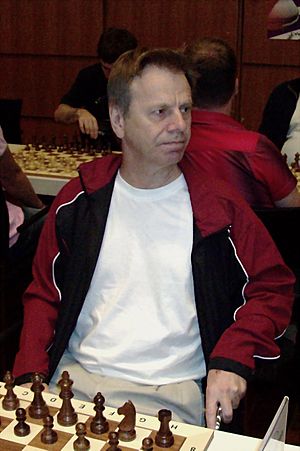Ulf Andersson facts for kids
Quick facts for kids Ulf Andersson |
|
|---|---|

Andersson in 2008
|
|
| Country | Sweden |
| Born | 27 June 1951 Västerås, Sweden |
| Title |
|
| FIDE rating | 2516 (December 2025) |
| Peak rating | 2655 (January 1997) |
| Peak ranking | No. 4 (January 1983) |
Ulf Andersson (born June 27, 1951) is a famous chess player from Sweden. He became an International Master in 1970. Just two years later, in 1972, he earned the highest title in chess, Grandmaster.
Contents
Ulf Andersson's Chess Journey
Early Success and Top Rankings
Ulf Andersson was one of the best chess players in the world. At his peak, he reached number four on the official FIDE rating list. This shows how strong he was against other top players.
He won or shared first place in many important tournaments. Some of these include the Swedish Chess Championship in 1969, Dortmund in 1973, and Wijk aan Zee in 1983. He also won in Hastings (1978–79) and Phillips & Drew (1980, 1982).
Big Matches and Team Play
In 1983, Andersson played a six-game match against former world champion Mikhail Tal. The match ended in a draw, which was a great achievement. He also played on the top board for "The Rest of The World" team in a big match against the USSR team in 1984.
Ulf led the Swedish team in the Chess Olympiad during the 1970s and 1980s. This is a major international team chess tournament. His best personal result was in the 1978 Chess Olympiad in Buenos Aires. He finished third on the first board, showing his skill against the world's best. Even now, in his seventies, Andersson still plays in chess tournaments sometimes.
Ulf Andersson's Playing Style
A Solid Positional Player
Andersson is known as a very solid positional player. This means he focuses on placing his pieces in good spots. He likes to control the board slowly and carefully. He often tries to gain small advantages over time.
He is also known for having many draws in his games. A draw happens when neither player wins. This shows how hard it was for other Grandmasters to beat him.
Master of Endgames
Ulf Andersson is especially famous for his amazing skills in endgames. The endgame is the final part of a chess game, when there are only a few pieces left. He is very good at rook endgames. He could often win games that seemed impossible to win. These games were sometimes very long.
Chess expert Jacob Aagaard said that Andersson is a "prophylactic player." This means he is very good at seeing his opponent's plans in advance. He avoids dangers with great skill. Another chess writer, Dennis Monokroussos, noted that for Andersson, trading pieces often meant his opponent was about to face a tough challenge, not an easy draw.
Correspondence Chess Career
Playing by Mail
Ulf Andersson started playing correspondence chess in 1995. In this type of chess, players send their moves to each other, often by mail or email. He became a correspondence chess Grandmaster in the same year. It's rare for a player to be so successful in both regular (over-the-board) chess and correspondence chess.
For Ulf, correspondence chess was a relief. He often felt nervous in regular games. In correspondence chess, he had plenty of time to think about each move. This allowed him to play very tactical games, which was different from his careful style in over-the-board chess.
Top Rankings and Retirement
In 1998, Ulf Andersson achieved the highest provisional rating in ICCF history. His rating was an incredible 2821. He reached the top of the official ICCF rating list in 2002.
In the early 2000s, many correspondence chess players started using computers to help them. Ulf was one of the few who still played without computer help. As email tournaments became faster, he found it hard to send moves quickly enough. He felt he had to send moves before he was fully satisfied. He decided to stop playing correspondence chess in 2003. He found it too demanding.
Despite these changes, Ulf Andersson lost only one official game in his entire correspondence chess career. As of 2024, he is still the highest-rated inactive player on the ICCF rating list.
Famous Games
Beating a World Champion
Ulf Andersson is known for a special chess setup called the "Hedgehog." In this setup, pawns are placed on a6, b6, d6, and e6. Knights are on d7 and f6, and bishops on b7 and e7. A rook is on c8, and the king castles on the kingside. This formation helps control the board and create counterattacks.
Here is a famous game where Andersson used the Hedgehog to beat Anatoly Karpov. This was Karpov's first loss as world champion!
| h | g | f | e | d | c | b | a | ||
| 1 |

|
1 | |||||||
| 2 | 2 | ||||||||
| 3 | 3 | ||||||||
| 4 | 4 | ||||||||
| 5 | 5 | ||||||||
| 6 | 6 | ||||||||
| 7 | 7 | ||||||||
| 8 | 8 | ||||||||
| h | g | f | e | d | c | b | a | ||
See also
 In Spanish: Ulf Andersson para niños
In Spanish: Ulf Andersson para niños

